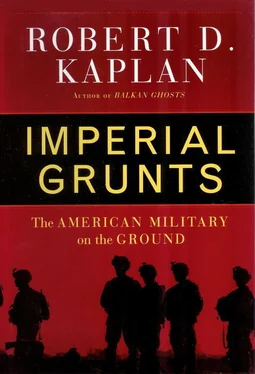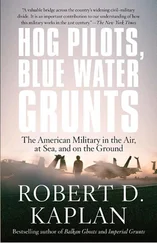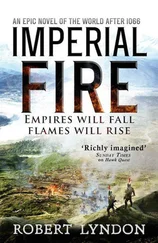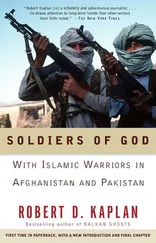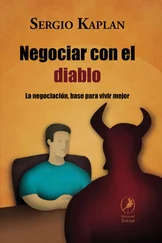“The threat level at the embassy from narco-terrorists has increased significantly,” noted Maj. Quiros dourly. “Where?” Duke asked. “At this embassy, and at your hotel,” Maj. Quiros replied, looking at me in a manner both genial and threatening. A diagram of the embassy grounds was taped on a stretched camouflage poncho that served as a wall partition. Maj. Quiros outlined which officers would control what “fields of fire” in case the embassy was attacked, who would keep the “comms” (communications) going, and who would stay behind here in the “cheesebox” to blow up the safe boxes that held stacks of classified documents.
The brief continued. A congressional delegation would be arriving. Along with the congressmen and their staffers, it would include a few Marine escorts, meaning that some U.S. troops would have to be moved out of Colombia temporarily to preserve the “force cap.” The force cap was a congressionally mandated limit on the number of uniformed U.S. troops that could be in-country at any one time to prevent mission creep. In El Salvador, with a population of five million in the 1980s, it had been fifty-five Special Forces trainers. In Colombia, whose population approached forty million, it was four hundred troops, including roughly seventy Special Forces trainers. The force caps were arbitrary, based more on political trade-offs in Washington than on any substantive analysis of what was required to get the job done. They simply reflected the fear of another Vietnam, even though the difference between having a few hundred elite troops in a country and hundreds of thousands of draftees was vast. Nevertheless, in an imperfect world, force caps were the ultimate guarantors of an Economy of Force strategy.
There was a discussion about the ammunition problem. Imperialism was less about conquest than about the training of local armies. Reliance on American techniques and weapons systems, and the relationships established between American officers and their third world protégés, helped give the U.S. the access it needed around the globe. And when Army Special Forces agreed to train a third world army, it also supplied the ammunition and equipment used in the training.
Arranging transport for the “palletized ammo” from Fort Bragg on C-130s and C-27s was turning out to be a chore. (The military shipped everything in aluminum pallets.) “It’s a bleak world out there as far as available aircraft are concerned,” reported Chief Warrant Officer Gleason in a flat Nebraskan accent.
Pat Gleason, like many noncommissioned sergeants and warrant officers I would meet in the course of my travels, was quietly amazing. From his laptop he ran the equivalent of a small travel agency and moving company, shuttling troops and equipment between the eastern United States, Puerto Rico, and Colombia. His Green Beret specialty was HALO (high altitude, low opening). He could jump out of a plane at night at 25,000 feet, opening the parachute at 3,500 feet. He spoke fluent Spanish and had served all over the Americas. With only one year at Campbell University in Buies Creek, North Carolina, he had a knowledge of South America (of the mores of the Chilean military, of political attitudes in rural Bolivia, and so on) that was nevertheless encyclopedic. Duke called him the team’s “collective, historical memory.”
There was, too, the issue of the new communications gear. Signals Capt. Bill Pittman, a West Point graduate from Georgia, said it was time “to raise the bullshit flag” about the plan to replace the old PSE-5 Delta “commo” system with a flyweight triband multi-channel package that bundled voice, data, secret, and nonsecret communications. The former system required a network of cumbersome outdoor antennae. The latter ran everything from secure telephones to unclassified PowerPoint briefings off a single eight-foot satellite dish. But it was complicated to operate and repair. Pittman worried that the operator-trainers wouldn’t stay long enough in Bogotá to transfer their knowledge, and the new system would end up as a broken toy that everyone stared at and didn’t know how to use properly.
All in all, it was a typical morning brief, thousands of which were held by the American military around the world every day.
I had dinner with Capt. Pittman the following night in Bogotá’s glitzy Zona Rosa district, a few blocks from my hotel. It was a night I won’t forget. Admiring the clean streets, bicycle paths, and sidewalk ramps for the handicapped from the restaurant window, and refreshing my palate with sorbet between courses, I might have been in any upscale American suburb. Compared to Caracas, Venezuela, where I had been some years before, Bogotá was low-key and dressed-down. The wealthy lived in apartments rather than in villas. It all seemed so thoroughly American. Then I saw that Pittman was distracted.
“What was that?” he said to the waiter, noticing the window shake. The waiter shrugged, unknowing.
We returned to our conversation. Pittman mentioned that Colombia was a bit reminiscent of the Pacific theater in World War II: jungly, disease-ridden, and chillingly violent in its hinterlands, and yet somewhat relegated by American policymakers because of larger events elsewhere. I told him that Bogotá reminded me of Santa Monica and Tel Aviv. Five minutes after Pittman had noticed the window shake his cell phone rang. It was the FOB informing him that five minutes before a big car bomb had exploded a few blocks from our restaurant and my hotel.
The concussion blast inside the exclusive El Nogal club, a haven for the Bogotá elite—accomplished with 440 pounds of fertilizer-based explosive—killed 32 people and wounded 260. Locals compared it to the 1995 Oklahoma City blast. It was the work of the Fuerzas Armadas Revolucionarias de Colombia, or FARC. Americans were not among the casualties, but the car bomb and a smaller blast the next day occurred near the American Embassy and hotels frequented by Americans.
The FARC’s origins dated to the communist agitation of the 1920s in rural Colombia, which came in the wake of the Russian Revolution, though in Colombia there had always been more banditry than Marxist philosophy, so that the fall of the Berlin Wall had little effect here. Indeed, it was difficult to know what the war was about anymore.
Lured by billions in annual cocaine-related profits, these leftist guerrillas, as well as rightist paramilitaries formed by local landowners in response to guerrilla outrages, drifted easily from a unifying ideology to localized anarchy, in which franchises arose built on murder and extortion. By the 1990s, Colombia’s homicide rates had tripled from already high levels, making Colombia more dangerous than even Brazil, Mexico, Nicaragua, and Panama. 12The tradition of an amoral paganistic Christianity, combined with the struggle over drug revenues, fed the sickening violence. Colombia demonstrated that the most basic human right is not freedom of speech but personal security. 13
The FARC, with its seventeen thousand or so fighters, no longer represented the shaggy-haired university idealists of the Cold War era, but a criminal army built on the forced recruitment of teenage boys and girls, in which desertion led to the slaughter of one’s family. FARC leader Mañuel Marulanda, perhaps the world’s oldest living guerrilla, might still have harbored ideals. But with an income variously estimated at $500 million annually in protection money from the cocaine business, the FARC was Karl Marx at the top and Adam Smith all the way down the command chain.
To wit, the FARC frequently set up roadblocks that would last for days, checking the names of drivers and passengers against a computer database to see if their bank accounts made them worthy of kidnapping. In Colombia, ideology was dead, as were historical grievances. Ethnic conflict had never been an issue. It was all about money.
Читать дальше
